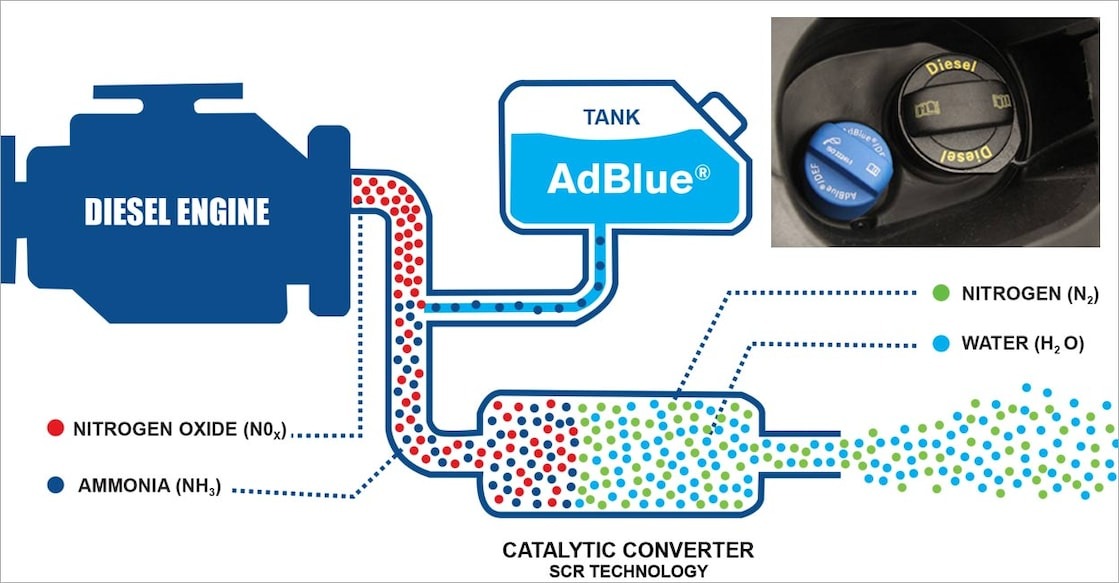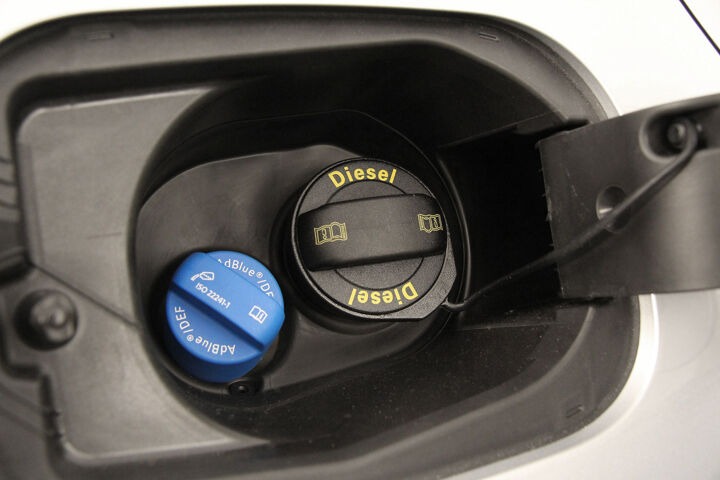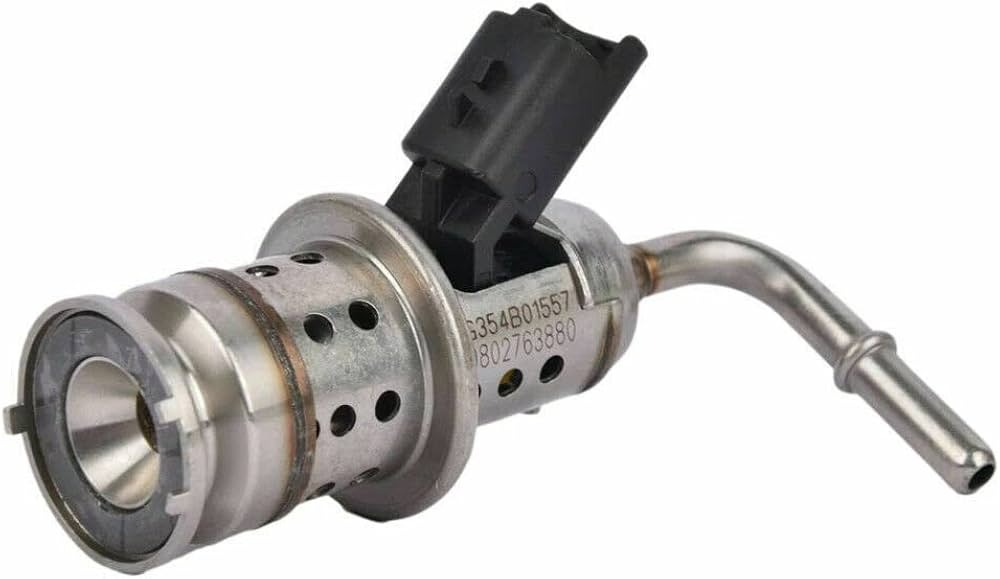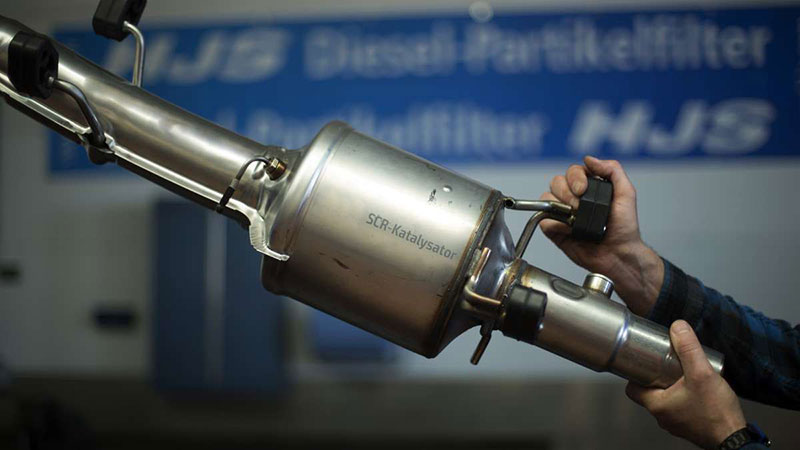

As environmental regulations tighten across the globe, automotive manufacturers have been forced to innovate and adapt new technologies to reduce emissions. One such innovation is the AdBlue system, a crucial component in modern diesel vehicles. You may have heard terms like “What is AdBlue?”, “How does the AdBlue system work?”, or even experienced a dreaded AdBlue system fault message on your dashboard. This article aims to demystify the AdBlue system, explaining its components, function, and the common issues drivers may encounter.
Whether you’re a car owner, mechanic, or just curious, this comprehensive guide will help you understand everything you need to know about the AdBlue system.
Table of Contents
ToggleThe AdBlue system is a type of Selective Catalytic Reduction (SCR) technology that uses a special fluid called AdBlue (a solution of 32.5% urea and 67.5% deionized water) to convert NOx gases in diesel exhaust into harmless nitrogen (N₂) and water vapor (H₂O).
Modern diesel engines are cleaner and more fuel-efficient than ever before. However, they still produce nitrogen oxides (NOx), which contribute to air pollution, smog, and respiratory problems. Governments worldwide have imposed stringent emissions standards, such as Euro 6 in Europe and Tier 3 in the United States, forcing manufacturers to implement advanced emissions-reduction technologies.
One such technology is the Selective Catalytic Reduction (SCR) system, which relies on AdBlue to convert NOx into nitrogen and water through a chemical reaction. Without AdBlue and an SCR system, many diesel vehicles would fail to meet these emission standards.

The AdBlue system is not optional; it is part of a vehicle’s certification to meet emissions standards. Tampering with or disabling the AdBlue system (via delete kits or software modifications) is:
Illegal in many countries.
Harmful to the environment.
Can void your vehicle’s warranty and cause inspection failure.
AdBlue is a brand name for a high-purity urea solution used in Selective Catalytic Reduction (SCR) systems to reduce nitrogen oxide (NOx) emissions in diesel engines. Chemically, AdBlue consists of 32.5% urea and 67.5% deionized water. It is a non-toxic, colorless, and odorless fluid, although it does have a slightly ammonia-like smell.
AdBlue is not a fuel additive. Instead, it is stored in a separate tank and injected into the vehicle’s exhaust stream, where it helps break down harmful NOx gases into harmless nitrogen (N2) and water vapor (H2O).
Common Misconceptions:
AdBlue is not fuel.
It is not flammable or explosive.
It does not improve engine performance directly.

A modern AdBlue system typically includes the following components:
Stores the urea solution.
Sizes vary between 5 to 30 liters depending on the vehicle.

Precisely sprays AdBlue into the exhaust stream.

A special catalytic converter where the chemical reaction takes place.
Converts NOx to nitrogen and water.

Manages AdBlue dosing based on exhaust gas temperature, engine load, and vehicle speed.
NOx sensors: Monitor the effectiveness of the SCR system.
Temperature sensors: Ensure the exhaust is within optimal operating range.
AdBlue level sensors: Alert the driver when fluid is low.
Prevent the AdBlue fluid from freezing in cold temperatures (AdBlue freezes at -11°C or 12.2°F).
The AdBlue system, a critical part of modern diesel emission control, uses Selective Catalytic Reduction (SCR) technology to transform harmful nitrogen oxides (NOx) into environmentally benign gases. Below is a comprehensive, step-by-step explanation of how the system operates in real-world driving conditions:

Inside the engine’s combustion chamber, diesel fuel is injected and ignited under high pressure and temperature. This process provides the necessary power to propel the vehicle but also produces exhaust gases containing:
Carbon dioxide (CO₂)
Hydrocarbons (HC)
Particulate Matter (PM)
Carbon monoxide (CO)
Most importantly, Nitrogen Oxides (NO and NO₂), collectively called NOx
These NOx gases are significant contributors to air pollution, smog, and respiratory issues, and thus must be treated before reaching the atmosphere.
As exhaust gases exit the engine and flow through the exhaust system, they pass a series of high-precision sensors, including:
NOx sensors (located before and after the SCR catalyst)
Temperature sensors
Pressure sensors
These sensors measure:
The amount of NOx present in the exhaust
The temperature of the exhaust gases
The engine load and speed
The data is transmitted in real time to the Electronic Control Unit (ECU), which acts as the brain of the SCR system.
The ECU analyzes sensor data to calculate:
The exact amount of AdBlue required to chemically reduce the NOx gases
The timing of injection to maximize the reaction’s efficiency
Several parameters are taken into account:
Exhaust gas temperature
Volume and flow rate of exhaust gases
NOx concentration
Current engine load and driving speed
This ensures the right amount of AdBlue is injected at precisely the right moment—too little AdBlue results in incomplete conversion; too much may lead to ammonia slip (excess NH₃ in the exhaust).
Once the ECU has determined the appropriate dose, it commands the AdBlue injector (also known as the dosing module) to spray a fine mist of AdBlue into the exhaust stream. This usually happens upstream of the SCR catalyst.
The injector must atomize the fluid effectively to ensure complete vaporization and decomposition. This process is highly dependent on:
Exhaust gas temperature (ideally above 200°C or 392°F)
Proper injector functioning and alignment
Clean, uncontaminated AdBlue (32.5% urea and 67.5% deionized water)
Once AdBlue is introduced into the hot exhaust gas stream, it undergoes thermal decomposition in two stages:
Stage 1: Evaporation
The water content in AdBlue evaporates due to the high exhaust temperature.
This leaves behind solid urea particles.
Stage 2: Thermolysis and Hydrolysis
The urea breaks down into ammonia (NH₃) and isocyanic acid (HNCO).
HNCO further reacts with water vapor in the exhaust to produce more ammonia and carbon dioxide (CO₂).
The net result is:
AdBlue → NH₃ (ammonia) + CO₂ (carbon dioxide)
Ammonia is the active reducing agent required for the chemical reaction in the SCR catalyst.
With ammonia now present in the exhaust stream, it enters the SCR catalyst, which is coated with precious metals or specialized materials like:
Vanadium oxide
Zeolites
Titanium dioxide
Here, the ammonia (NH₃) reacts with the NOx gases (NO and NO₂) in the presence of the catalyst. The reaction is:
4NO + 4NH₃ + O₂ → 4N₂ + 6H₂O
2NO₂ + 4NH₃ + O₂ → 3N₂ + 6H₂O
These chemical reactions convert dangerous NOx into:
Nitrogen gas (N₂) – makes up 78% of Earth’s atmosphere and is harmless
Water vapor (H₂O) – also safe and naturally occurring
This is a non-reversible chemical reaction, ensuring permanent NOx removal from the exhaust stream.

After the SCR reaction is complete:
The cleaned exhaust exits the tailpipe
The downstream NOx sensor checks to verify that emissions have been reduced to acceptable levels
The vehicle complies with Euro 6, EPA Tier 2, or other emissions standards
The entire process is passive and seamless to the driver, with no impact on engine performance or fuel economy. However, failure to maintain the AdBlue system may result in:
Dashboard warnings
Engine start restrictions
Fault codes like “AdBlue System Fault” or “No Engine Start in XXX miles/km”
Most modern diesel vehicles will display a dashboard warning light when AdBlue levels are low. If the AdBlue tank is not refilled:
The vehicle may go into limp mode, reducing performance.
Eventually, the engine will not restart once turned off.
Some vehicles disable certain driving functions for emissions compliance.
This is not a flaw but a legal requirement under emissions law to ensure compliance.
An AdBlue system fault refers to any issue in the SCR system that prevents it from operating correctly. This fault may trigger warning lights, engine warning messages, or even prevent the engine from starting. Below are the most common types of AdBlue system faults:
Low AdBlue Fluid Level
Caused by natural consumption; easily fixed by topping up.
Clogged Injector Nozzle
AdBlue crystallizes when exposed to air, potentially clogging the injector.
Faulty NOx Sensors
If the sensors fail, the ECU cannot monitor emissions and may limit engine operation.
Freezing of AdBlue
In very cold climates, if the heating elements fail, the AdBlue may freeze and block the system.
ECU Communication Error
Wiring issues or faulty control modules can disrupt dosing control.
Poor Quality or Contaminated AdBlue
Using substandard fluid can damage system components.
AdBlue-related faults are often shown as warning lights, dashboard messages, or Diagnostic Trouble Codes (DTCs) read by scan tools. While the underlying issues are often similar—usually relating to dosing, sensors, or low fluid—each manufacturer has its own set of error codes and logic.
Mercedes vehicles often label AdBlue faults with DTCs starting with P13, P20, or P2BA series.
| Code | Meaning |
|---|---|
| P13E400 | “AdBlue system: Engine start not possible in XX km” – Triggered when system detects repeated SCR failures or low fluid over long period. |
| P2BAD | NOx Out Of Range After SCR – Indicates SCR system isn’t reducing NOx properly. Could be dosing fault, failed injector, or bad catalyst. |
| P204F | Reductant System Performance – Generic code for performance degradation in AdBlue system. Could involve pump, heater, or injector. |
| P20E8 | Reductant Pressure Too Low – Often points to a failing AdBlue pump or clogged line. |
| P205B | Reductant Tank Temperature Sensor Circuit Range/Performance – Faulty temperature reading can affect dosing strategy. |
| P20BD | Reductant Injector Circuit Open – Electrical failure in AdBlue injector circuit. |
Symptoms in Mercedes:
Countdown warning “Engine start not possible in 500 km”
Yellow or red AdBlue warning light
Check Engine Light (MIL)
Reduced engine performance in limp mode (if system fails completely)
=> You may also like:
Audi uses a mix of P20, P2BA, and B-codes in its VAG-based diagnostic system (shared with VW, Skoda, SEAT).
| Code | Meaning |
|---|---|
| P20E8 00 | Reductant pressure too low – Often a result of a weak pump, frozen lines, or injector clog. |
| P204F00 | Reductant system performance – Indicates SCR not meeting emission targets; multiple causes possible. |
| P207F00 | Reductant Quality Sensor Range/Performance – Sensor might read contaminated fluid or be faulty. |
| B10151B | Battery isolation igniter resistance too high – While not directly AdBlue, it often appears after accidents that disable SCR systems. |
| P20C1 | Heater performance – Reductant tank – Can occur in cold climates when fluid freezes. |
Symptoms in Audi:
“AdBlue range: 1000 km” warning countdown
NOx warning light or EPC light
Reduced performance or torque limitation
Diagnostic scan required to reset countdown after repair
BMW refers to AdBlue as DEF (Diesel Exhaust Fluid) and uses 168, 20, and 4D series fault codes.
| Code | Meaning |
|---|---|
| 168A44 | Reductant system: Warning threshold for start lock reached – One of the most common warnings. Triggers countdown. |
| 168A45 | Start lock active – Car will no longer start unless error is cleared or repaired. |
| 20E8 | Reductant pressure too low – Usually a bad pump or frozen lines. |
| 20EA | Reductant heater malfunction – Can trigger in cold temperatures. |
| 4D32 | SCR catalytic converter efficiency below threshold – Catalyst not converting NOx efficiently. |
| 20F0 | Incorrect AdBlue fluid – Detected if water-contaminated or wrong fluid is used. |
Symptoms in BMW:
“No engine start possible in XXX km”
DEF warning on iDrive screen
Power reduction
Engine light or SCR system malfunction
⚠️ Additional Notes:
All brands use a “countdown to no start” strategy if AdBlue problems persist.
After some fault codes, repair alone is not enough—a diagnostic tool is needed to clear codes and reset the countdown.
Faults can arise from bad AdBlue fluid, freezing, air bubbles in the line, or sensor calibration issues.
Here are some best practices to keep your AdBlue system running smoothly:
✔ Use High-Quality AdBlue
Only purchase AdBlue from reputable brands with ISO 22241 certification.
✔ Keep the Cap Sealed
AdBlue degrades over time, especially if exposed to air and sunlight.
✔ Maintain Regular Refills
Never let your tank run dry. Always top up when prompted.
✔ Service SCR System Periodically
Have injectors and sensors inspected during regular service intervals.
✔ Drive Your Diesel Vehicle Regularly
Short city trips may not heat the exhaust enough to operate the SCR system effectively.
9.1. How Often Do You Need to Refill AdBlue?
AdBlue consumption depends on the vehicle, engine load, and driving conditions. On average:
1 liter per 600-1000 km (370-620 miles) is a common rate.
Tanks are typically designed to last 10,000-15,000 km (6200-9300 miles) between refills.
Your vehicle’s dashboard will alert you well in advance, often with warnings appearing when 2,400 km (1500 miles) of range remain.
9.2. Can You Drive Without AdBlue?
In short, you can’t drive for long without AdBlue in vehicles that require it. Running out of AdBlue will:
Trigger dashboard warnings.
Limit vehicle performance.
Eventually result in no engine restart after shutdown.
By law, the system must enforce these restrictions to remain emissions compliant.
As emissions standards continue to evolve, the role of the AdBlue system is expanding:
Newer vehicles use dual dosing systems with improved precision.
SCR technology is being adapted for light commercial vehicles, trucks, and off-road equipment.
Future fuels may reduce NOx emissions at the source, but AdBlue remains the most effective NOx control method for diesel engines today.
The AdBlue system is a vital technology that enables diesel vehicles to meet strict environmental standards without compromising performance. Understanding what AdBlue is, how it works, and how to respond to an AdBlue system fault ensures that your vehicle remains reliable, legal, and eco-friendly.
With proper maintenance, quality fluid, and attention to warning signs, your SCR system can function flawlessly for years. Whether you’re a vehicle owner or a technician, recognizing the value and operation of this system is essential in today’s diesel world.
If you’re experiencing recurring AdBlue system faults, or your diesel vehicle shows warnings you don’t fully understand, our team at AutoExplain is here to help. We offer:
✔ Step-by-step remote diagnostic guidance
✔ Verified part recommendations
✔ 24/7 expert technical support
Let us help you fix your AdBlue issues efficiently and affordably.
📞 Contact us via WhatsApp: +1(936)2896695
🌐 Visit us online at AutoExplain
=> Read more about our car repair online service here!








At AutoExplain, we provide automotive online repair service, auto repair tips, car repair manuals & document & training course to help mechanics of all experience levels—fix vehicles efficiently
AUTO EXPLAIN LLC
Employer Identification Number (EIN):
38-4349958
Whatsapp Us: +1(936)2896695
Gmail: [email protected]
Our Workshop: 1500 N Grant ST Sten Denver, Colorado, United States
Copyright 2025 © AutoExplain